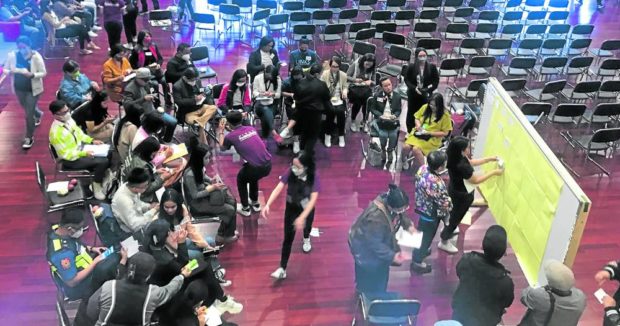Baguio kids perform poorly in English – DepEd survey

EDUCATION SUMMIT | Parents, civil society groups, Baguio businessmen, and government officials put their heads together at a Baguio education summit on Jan. 20 to address a literacy problem plaguing the city’s grade schoolers after two years of distance learning. (Photo by VINCENT CABREZA / Inquirer Northern Luzon)
BAGUIO CITY, Benguet, Philippines — Only four of every 10 kids aged 9 to 12 years old in Baguio City can properly read and write in English, according to a 2021-2022 performance survey by the Department of Education (DepEd) in this city.
The finding, revealed by DepEd officials and Mayor Benjamin Magalong in an education summit here on Friday, prompted parents, educators, and members of civil society in the summer capital to band together and solve the children’s dropping literacy skills.
The “reality that only a third of [that age group] is literate” meant the whole community’s assistance would be required to help these children, Magalong said when he opened the summit that was steered by education advocate Synergeia Foundation.
According to Baguio Schools Division Superintendent Federico Martin, the survey showed that four out of 10 pupils in Grades 4 to 7 can read or write in English, while less than half of pupils in Grades 3 (age 8 or 9 years old) to 7 could read or write in Filipino after measuring results from pretests and post-tests conducted during school year 2021-2022.
Martin’s presentation at the summit showed the pupils who took part in the pretest for English numbered 3,823 while 3,808 took the post-test. Those who took the pretest for Filipino totaled 2,620 pupils while 2,707 took the post-test.
Article continues after this advertisementThe report did not, however, indicate the sampling size in relation to the total number of pupils in the surveyed grade levels.
Article continues after this advertisementMartin’s report also showed that eight of every 100 pupils in 2021 could not complete Grade 6 or Grade 10 in junior high school.
Mediation a must
The study did not explain the low literacy level or why students were dropping out of school, but Magalong attributed the poor performance to poverty and lack of access to tools required by the children for blended learning methods, among others.
Mediation must happen now before poor literacy impacts on the children 10 to 20 years down the line, the mayor added.
The performance study was made two years after the country’s quarantine rules kept schoolchildren restricted at home from 2020 to 2021 after the coronavirus pandemic broke out in March 2020.
All grade school and high school pupils took classes at home using activity workbooks or canned lessons delivered online and over television and radio broadcasts. In-person classes resumed only toward the end of 2022, when most public health regulations eased.
Synergeia president Milwida Guevara stressed that Baguio’s literacy rate was still higher than the national reading average of 1:10 literate Filipino pupils from Grades 1 to 4, based on a World Bank report.
The performance survey also displayed how appropriate school support led to reading skills improvements, she pointed out.
For example, the “frustration” reading skills of Grades 4 to 7 Baguio pupils dropped from 29.7 percent during pretests to 12.5 percent during post-tests.
“Frustration reading,” Guevara said, refers to English text which 9- to 12-year-olds can “utter correctly but which they do not understand.”
“Instructional reading,” meanwhile, rose from 38.3 percent in pretests to 44 percent during post-tests, according to Martin.
Guevara said this refers to the skill level when 9- to 12-year-olds can understand English text but would require “guidance all the time.”
“Independent” reading levels, or when children understand English text with little assistance, improved from 31.3 percent in pretests to 43.5 percent after post-tests.
Public school enrollment
Baguio schools data collated by the DepEd showed a sustained reduction in private school enrollment in the previous school terms, and a corresponding spike in public school enrollment. A huge number of parents opted for the public school system after the lockdown years, Martin said.
Before the pandemic struck, public elementary and high schools here logged 61,117 enrollees during the 2018-2019 school term, and 57,236 enrollees during the 2019-2020 school year, according to Martin’s report.